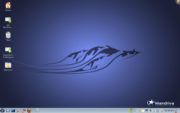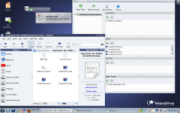Mandriva 2010
Mandriva 2010.0 is the latest achievement of the Mandriva community. According to the features page it is faster and sexier than ever. Released earlier this month, Mandriva 2010.0 has some interesting new features including Moblin, Sugar, and the so-called "Smart Desktop".
As usual, Mandriva is shipped in three flavors - One, Free and PowerPack. The Flash drive edition was not available when this article was written, but should be available soon. While PowerPack and One contain some non-free packages like drivers or patent encumbered multimedia codecs, Free is 100% freedom software. Mandriva recommends the free edition to advanced users, so that is what we reviewed.
Mandriva Free is available as an installation DVD for 32 (i586) and 64 bit architectures, together with a dual arch DVD which seems to be the same as a 32 bit one. At the time this article was written the reviewers guide had no information about this.
Mandriva has a tradition of being user friendly, with a touch of simplicity. The installer is no exception. It offers a partition setup based on the available free space in case there are other operating systems and data. It is also possible to configure a custom disk setup. KDE is chosen by default, with GNOME, other desktops and all available software on the DVD as an option. We chose all the defaults and the installation finished quickly. Advanced options are there for the users who need them.

Since the 100% free software edition was used, no non-free drivers or firmware were installed. Therefore my Thinkpad T61, which was used for the tests, was left with no hardware acceleration for the Nvidia Quadro graphics and no wireless connection with its Intel 4965 chip. After the non-free repository was added to rpmdrake, the necessary drivers and firmware became available for installation. A few clicks and an X restart made the hardware usable. Rpmdrake was very responsive on my system, starting and performing very quickly.
No more KDE3
KDE3 and its applications, such as Quanta Plus, have been discontinued in Mandriva 2010. The default setup should be familiar to KDE3 users, however, with the desktop set to Folder View, and the menu in the classic layout. While the default setup provides a safe landing for KDE3 users, the full KDE4 desktop is only a few clicks away.
The Smart Desktop is one of the most interesting features in Mandriva 2010. In a nutshell, the Smart Desktop tries to build a semantic, task based desktop on top of KDE's Nepomuk service. In order to be usable, Smart Desktop requires both Nepomuk and Stringi to be installed and running. Interaction with the user happens through the Task Management Widget and a program called Tasktop.

The concept is simple—files and information are gathered around a common context, called a task. The task is created through the widget or Tasktop, and allows the user to associate contacts, files, emails and web pages to the task. The service is integrated with the Dolphin file manager, which associates the files to the task through the Actions menu. Dolphin can list all the files associated with a certain task, and can add files to a task with a right click. Tasktop also has an 'Open in Dolphin' option, which opens a file manager window with all of the task's associated files, contacts, emails and web pages. Open/Save dialogs are also integrated into the Smart Desktop's task based semantic mode. For example you can save a file to a task using Dolphin.
The theory behind the Smart Desktop is very interesting. In practice the service is very new and other KDE applications have yet to be integrated. It would be nice to have an option to associate a contact to the task directly from the Kontact, or to do the same with a bookmark from Konqueror, but it's not there yet. It would be even nicer if this support were integrated into other applications such as GNOME PIM or Mozilla.
Sweet and mobile
Mandriva 2010.0 is a multi-purpose desktop. Beside the popular desktops like KDE and GNOME, Mandriva ships Sugar and Moblin desktops, available for installation through the task-sugar and task-moblin packages, according to the 2010 tour. Due to a conflict with the etoys package, task-sugar wasn't immediately available for installation.
Fortunately, task-moblin installed the Moblin GUI without any problems. Moblin is designed for netbooks, but the interface can be used on other hardware. Mandriva also claims to support a wide range of netbooks, so netbook users should have no problem using Moblin on Mandriva.
Other
The Mandriva Control Center has been updated. The network profiles management tool was redesigned and net_monitor was rewritten from scratch. Package management and updating is more usable and configurable now. The package search function is now able to use full names, versions and releases. The update system offers more configurable frequency settings. The Tomoyo security framework replaces AppArmor and is configurable with the Tomoyo-gui. New partitions are formatted as Ext4. Plymouth provides a pretty boot process, and if you like to benchmark you can install the phoronix-test-suite package.
Mandriva actively advertises Moovida, the renamed Elisa multimedia center with a new graphical user interface. Mandriva positions itself as a home multimedia center capable distribution, too.
Mandriva 2010.0 features the latest versions of many popular applications. KDE 4.3, GNOME 2.28, OpenOffice.org 3.1.1, Firefox 3.5.5, and Linux 2.6.31 are just some of the examples.
Conclusion
We experienced some small glitches during initial setup, the desktop froze during font configuration and there was an offer to upgrade to 2009.1, but these glitches didn't persist after the initial setup. Mandriva manages to pack a high quality desktop. Their careful approach with KDE4 settings will hopefully be enough compromise for those who dislike it, while the performance and responsiveness bring nothing but joy. The Smart Desktop is certainly a innovation and the most interesting part of this release.
| Index entries for this article | |
|---|---|
| GuestArticles | Jelic, Ivan |
Posted Nov 12, 2009 8:41 UTC (Thu)
by fcrozat (subscriber, #175)
[Link] (2 responses)
- Dual arch ISO is not a DVD but a CDROM (650MB), with a minimal desktop (LXDE) available in both x86 and x86-64 architecture (installation will use x86-64 architecture if system supports it), without additional download. During installation process, if user decides to add network media, installation will be equivalent to a Free DVD install, with packages download on the fly.
Thanks you for your review.
Posted Nov 12, 2009 9:44 UTC (Thu)
by attitude (guest, #24270)
[Link] (1 responses)
Posted Nov 12, 2009 9:54 UTC (Thu)
by fcrozat (subscriber, #175)
[Link]
Posted Nov 19, 2009 11:28 UTC (Thu)
by chojrak11 (guest, #52056)
[Link]
Mandriva 2010
- we are aware of the desktop freeze while "live upgrade" from Mandriva 2009 or 2009 Spring is in progress. We are investigating this issue and until it is resolved, we disabled "live upgrade" notification to Mandriva Linux 2010. For people who encountered the crash, log as root in a virtual terminal and run "urpmi --auto-update --auto --replacefiles" to finish the upgrade. For users who did not upgrade yet, we suggest using DVD ISO to do the upgrade until we enable "live upgrade".
-we will investigate etoys vs task-sugar issue.
Thank you for the comments. Anyway, here is the thing with a dual arch
download. If you go here you'll find "DVD 32bits (4,3GB)", "DVD 64 bits" and "DVD dual
arch" torrents. Both links for the 32 bits and dual arch are the same, which
means 4,3GB ISO.
Mandriva 2010
Mandriva 2010
Mandriva-based Server

